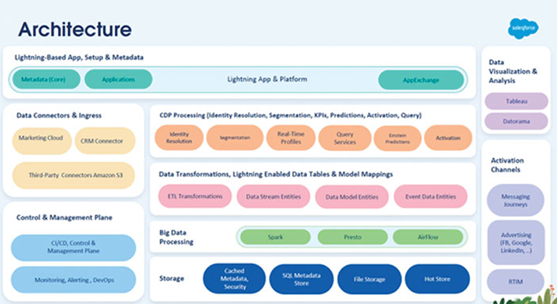This chapter introduces the reader to the Salesforce Data Cloud architecture. We will delve into a detailed examination of the key building blocks of Salesforce Data Cloud and understand how they interact with each other.
We will start our discussion with the Salesforce Data Cloud architecture, followed by a deeper examination of its various components. This will allow us to understand and appreciate how Salesforce Data Cloud gets its power from. Next, we will distinguish between Salesforce and the Salesforce Data Cloud technical architecture.
Furthermore, we will discuss the technical benefits of Salesforce Data Cloud and learn how to drive productivity, efficiency, and value with it. In the end, we will discuss about the integration of different capabilities into Commerce, Sales, Service, and Marketing Cloud with the addition of Salesforce Data Cloud.
In this chapter, the following topics will be covered:
- Salesforce Data Cloud Architecture
- Difference Between Salesforce Architecture and Salesforce Data Cloud Architecture
- Key Technical Benefits Offered by the Salesforce Data Cloud Platform
- Salesforce Applications Powered by Salesforce Data Cloud
Salesforce Data Cloud Architecture
The architecture of Salesforce Data Cloud consists of several key components, including:
- Data Sources: The data sources component is responsible for collecting and ingesting data from various sources, such as social media platforms, data providers, and customer relationship management (CRM) systems. The platform supports both batch and real-time data ingestion, which allows businesses to access the most up-to-date data.
- Data Storage: The data storage component is responsible for storing the ingested data in a centralized data warehouse. The platform uses a variety of data storage technologies, such as Hadoop, Amazon S3, and Microsoft Azure, to store and manage the data. The data storage component provides scalable and flexible data storage, which allows businesses to store large amounts of data and retrieve it quickly and efficiently.
- Data Management: The data management component is responsible for cleaning, transforming, and enriching the data. The platform uses a variety of data management techniques, such as data normalization, data standardization, and data enrichment, to ensure that the data is accurate, consistent, and actionable.
- Data APIs: The data APIs component is responsible for exposing the data to other applications and services. The platform provides a range of APIs, such as REST APIs and SOAP APIs, that enable businesses to access the data and integrate it into their existing workflows and applications.
- Data Analytics and Insights: The data analytics and insights component is responsible for providing insights into the data and helping businesses make better decisions. The platform provides a range of data analytics and reporting tools, such as dashboards, charts, and reports, that enable businesses to visualize and analyze the data.
- Data Security and Privacy: The data security and privacy component is responsible for ensuring that the data is secure and protected. The platform uses a range of security and privacy features, such as encryption, access controls, and data governance policies, to protect the data from unauthorized access and to ensure compliance with data privacy regulations.
Figure 4.1 shows the architecture of Salesforce Data Cloud.

Figure 4.1: Salesforce Data Cloud Architecture Diagram
Salesforce Data Cloud is built on AWS. It uses many services offered by AWS for storage, data processing, data transformation, and the like. Let us now examine the architecture diagram.
There are different building blocks in the architecture diagram, and we will look at them one by one.
